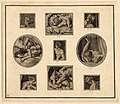File:Print (BM Ii,16.6.1-9 07).jpg
Print_(BM_Ii,16.6.1-9_07).jpg (449 × 430 pixels, file size: 89 KB, MIME type: image/jpeg)
| This is a file from the Wikimedia Commons. Information from its description page there is shown below. Commons is a freely licensed media file repository. You can help. |
Summary
| print
( |
||||||||||||||||||||||||
|---|---|---|---|---|---|---|---|---|---|---|---|---|---|---|---|---|---|---|---|---|---|---|---|---|
| Artist |
Print made by: Agostino Veneziano (?)
|
|||||||||||||||||||||||
| Title |
print |
|||||||||||||||||||||||
| Description |
English: Nine fragments depicting the 'Loves of the Gods' (I Modi ['the Positions']), mounted on a sheet; four depicting a female head in profile, three depicting the naked upper torso and head of a female reclining on a bed in various positions suggesting intercourse; two nude males seen from the torso up
Engraving |
|||||||||||||||||||||||
| Depicted people | Representation of: Terminus | |||||||||||||||||||||||
| Date |
between 1510 and 1520 date QS:P571,+1550-00-00T00:00:00Z/7,P1319,+1510-00-00T00:00:00Z/9,P1326,+1520-00-00T00:00:00Z/9 |
|||||||||||||||||||||||
| Medium | paper | |||||||||||||||||||||||
| Dimensions |
|
|||||||||||||||||||||||
| Collection |
institution QS:P195,Q6373 |
|||||||||||||||||||||||
| Current location |
Prints and Drawings |
|||||||||||||||||||||||
| Accession number |
Ii,16.6.1-9 |
|||||||||||||||||||||||
| Notes | These have traditionally been regarded as the only surviving fragments of Marcantonio's famous series of 'I Modi'. They are discussed by James Grantham Turner in 'Print Quarterly' December 2004, XXI, pp.369-79, who concludes that they come from a single 'replacement' set for Marcantonio's originals, re-engraved in the same direction perhaps by Agostino Veneziano. In this case no original engraving or fragment of one survives. Each fragment is further discussed by James Grantham Turner in 'Art and love in Renaissance Italy', Metropolitan Museum of Art, New York, 2008, cat.99, pp.200-202, | |||||||||||||||||||||||
| Source/Photographer | https://www.britishmuseum.org/collection/object/P_Ii-16-6-1-9 | |||||||||||||||||||||||
| Permission (Reusing this file) |
© The Trustees of the British Museum, released as CC BY-NC-SA 4.0 | |||||||||||||||||||||||
| Other versions |
|
|||||||||||||||||||||||
Licensing
This image is in the public domain because it is a mere mechanical scan or photocopy of a public domain original, or – from the available evidence – is so similar to such a scan or photocopy that no copyright protection can be expected to arise. The original itself is in the public domain for the following reason:
This tag is designed for use where there may be a need to assert that any enhancements (eg brightness, contrast, colour-matching, sharpening) are in themselves insufficiently creative to generate a new copyright. It can be used where it is unknown whether any enhancements have been made, as well as when the enhancements are clear but insufficient. For known raw unenhanced scans you can use an appropriate {{PD-old}} tag instead. For usage, see Commons:When to use the PD-scan tag. | |||||
Captions
Items portrayed in this file
depicts
image/jpeg
File history
Click on a date/time to view the file as it appeared at that time.
| Date/Time | Thumbnail | Dimensions | User | Comment | |
|---|---|---|---|---|---|
| current | 16:20, 12 May 2020 |  | 449 × 430 (89 KB) | Copyfraud | British Museum public domain uploads (Copyfraud/BM) Eroticism in the British Museum 1510 image 8 of 13 #1,221/1,471 |
File usage
The following page uses this file:
Global file usage
The following other wikis use this file:
- Usage on fr.wikipedia.org
Metadata
This file contains additional information, probably added from the digital camera or scanner used to create or digitize it.
If the file has been modified from its original state, some details may not fully reflect the modified file.
| Software used | Adobe Photoshop Elements for Windows, version 2.0 |
|---|




